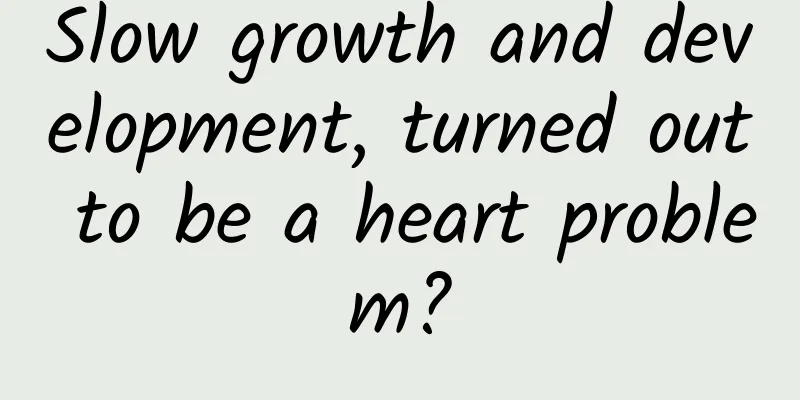Slow growth and development, turned out to be a heart problem?

|
Author: Zhang Zhifang, deputy chief physician at Shanghai Children's Medical Center, Shanghai Jiao Tong University School of Medicine Reviewer: Chen Yiwei, deputy chief physician, Shanghai Children's Medical Center, Shanghai Jiao Tong University School of Medicine Xiaoyueliang (pseudonym) is a 3-year-old girl, but in kindergarten, her height and body are much worse than other children. At the age of 3, she is 87cm tall and weighs 10.6kg. She is not very enthusiastic about playing games and prefers to sit quietly and draw. According to Xiaoyueliang's mother, the child was born at full term, and the doctor said that the score and weight were good when she was born. However, during infancy, her mother found that Xiaoyueliang was prone to sweating when sucking milk, eating slowly, and was easily irritable. She thought that she was not experienced in raising children and the feeding method was wrong, so she did not actively seek medical treatment. As Xiaoyueliang grew up, her appetite has always been small, and her food intake cannot keep up with children of the same age. Her growth and development lags behind the standard growth curve. Moreover, Xiaoyueliang likes to be quiet and does not like to run and jump outside. Sometimes she will breathe heavily after activities. During the physical examination for admission to the kindergarten, she was told that the child had a heart murmur and suggested taking Xiaoyueliang to a children's specialist hospital for a thorough examination. After a pediatric specialist examination, it was found that Xiaoyueliang not only did not meet the height and weight standards, but also had multiple problems such as liver enlargement, heart enlargement, heart murmurs, etc. Further cardiac ultrasound examinations showed dilated cardiomyopathy and heart failure. After a series of diagnosis and treatment in the hospital, Xiaoyueliang's appetite gradually increased and his weight also increased. After reexamination, his heart function indicators also improved, but he still needs to receive close follow-up examinations and drug treatment. Figure 1 Copyright image, no permission to reprint 1. What is dilated cardiomyopathy? Dilated cardiomyopathy, also known as congestive cardiomyopathy, is the most common type of cardiomyopathy in children. It can manifest as enlargement of the entire heart, mainly left ventricle enlargement, and weak cardiac contractions, often accompanied by heart failure or even heart failure. 2.What are the main manifestations of dilated cardiomyopathy? Most children with dilated cardiomyopathy often show symptoms of fatigue, loss of appetite, and inactivity. Some children may experience abdominal pain. In infancy, they may experience feeding difficulties, poor weight gain, breathing difficulties when sucking milk, irritability and sweating. Some children may even experience cardiogenic syncope. Physical examinations may reveal enlarged heart and heart murmurs. In cases of heart failure, there may be lower limb edema, hepatomegaly, gallop rhythm, etc. 3.What are the common causes of dilated cardiomyopathy? At present, the cause of dilated cardiomyopathy in most patients is still not very clear. It may be related to factors such as gene mutation (MYH7, MYBP3), genetics, arrhythmia (atrial tachycardia, preexcitation syndrome), metabolism (such as carnitine deficiency) and nutritional disorders (such as selenium deficiency). Figure 2 Copyright image, no permission to reprint 4. Is having dilated cardiomyopathy a “death sentence”? In the late stage of dilated cardiomyopathy, heart failure is often present, which affects the heart's pumping function. Although heart failure is the most important direct cause of death from cardiovascular disease, having dilated cardiomyopathy does not mean you are "sentenced to death." If a clear cause can be found, such as arrhythmia (atrial tachycardia, preexcitation syndrome), metabolism (such as carnitine deficiency), etc., and targeted treatment is given, the child can fully recover. For other children with unknown causes, standardized, individualized anti-heart failure drugs and device treatments can also partially improve heart function and delay the progression of the disease. Children with terminal dilated cardiomyopathy and heart failure can be treated with heart transplantation. 5. How do we standardize the treatment of dilated cardiomyopathy? To deal with dilated cardiomyopathy, the main treatment is symptomatic treatment, that is, for heart failure, drug treatment combined with lifestyle improvement. From avoiding respiratory infections, excessive fatigue and other inducements, to timely medical treatment, standardized medication, monitoring and management of diet, water intake and weight changes, every link cannot be sloppy. It is particularly important to emphasize that standardized medication is still needed when the condition is stable. The cornerstone of anti-heart failure treatment is the standardized and sufficient use of drugs that can improve the prognosis of heart failure. When heart failure reaches a certain extent, non-drug treatment methods can also be considered according to the condition, such as cardiac resynchronization therapy, implantable cardioverter defibrillator, ventricular assist device treatment, heart transplantation, etc. It is most important for parents to pay enough attention, detect their children's symptoms and changes in their condition early, and cooperate with doctors for long-term disease management and treatment. 6. Do I need to take the medicine for treating dilated cardiomyopathy for life? There are two types of therapeutic drugs: one is drugs that help relieve symptoms, such as diuretics, vasodilators or cardiotonic drugs; the other is drugs that help prolong survival, including angiotensin-converting enzyme inhibitors (ACEI)/angiotensin II receptor blockers (ARB)/, angiotensin receptor/neprilysin inhibitors (ARNI), beta-blockers, aldosterone antagonists, sodium-glucose co-transporter 2 inhibitors (SGLT2i), sinus node inhibitors, and new soluble guanylate cyclase agonists. The first drug is only used when symptoms are obvious or aggravated, while the second needs to be taken for a long time and in sufficient amounts. Of course, there are many things to pay attention to and observe when using heart failure drugs, so it is best to use and adjust them under the guidance of a doctor. Figure 3 Copyright image, no permission to reprint 7. Under what circumstances is a heart transplant necessary? Are there artificial hearts? Due to the scarcity of transplant donors and the high cost of transplantation, heart transplantation is usually used as an unconventional treatment for advanced heart failure, especially for pediatric heart transplantation. At present, there are not many hospitals in China that can perform pediatric heart transplantation. The Shanghai Children's Medical Center affiliated to the School of Medicine of Shanghai Jiaotong University, where the author works, has performed the first pediatric heart transplant since 2019, and has completed 12 pediatric heart transplants by 2024. The research and development of artificial hearts has never stopped, but so far, permanent artificial heart transplantation surgery is still immature. However, ventricular assist devices are relatively mature and are usually used as a transition while waiting for a heart transplant, and can even be used for long-term treatment. 8. Is there any new hope for the treatment of dilated cardiomyopathy? With the advancement of science and technology and the active development of medical research, new treatment methods continue to emerge. In recent years, a number of new drugs that can improve the prognosis of heart failure have emerged in the field of heart failure, including angiotensin receptor/neprilysin inhibitors (ARNI), beta-blockers, aldosterone antagonists, sodium-glucose cotransporter 2 inhibitors (SGLT2i), and new soluble guanylate cyclase agonists (Vericiguat). The "five golden flowers" represented have achieved good results in improving heart failure. I believe that there will be more new hopes in the future. 9. After heart failure occurs, how to comprehensively manage the child’s lifestyle? Patients with heart failure need a light diet and should not consume too much salt. Strict restriction of sodium intake is not recommended in mild or stable stages. Patients with heart failure who have symptoms with a little activity are advised to limit sodium intake to less than 3g/d. In acute heart failure with excessive volume load, sodium intake should be limited to less than 2g/d. Patients with mild to moderate heart failure do not need to routinely restrict their fluid intake. Patients with severe heart failure should limit their fluid intake to 1.5 to 2.0 L/d. The fluid intake here includes drinking water, porridge, soup, etc. It is better to take it in small amounts at several times. At the same time, the urine volume should be observed and recorded more often. In the stable stage of heart failure, the fluid intake and urine volume should be basically the same. Patients with heart failure should measure and record their weight at the same time and under the same conditions every day so that fluid retention can be detected in a timely manner. Reduce sitting for long periods of time and exercise gradually. For critically ill patients with chest tightness, shortness of breath, and inability to tolerate daily activities, physical activity should be strictly limited. After the condition stabilizes, the amount of exercise needs to be gradually increased appropriately, but it must be under the guidance of a doctor or professional, and an exercise plan must be developed according to personal circumstances. Finally, it should be pointed out that most domestic and international guidelines indicate that children with stable dilated cardiomyopathy can receive inactivated vaccines, and for attenuated vaccines, it is recommended that the decision on whether to vaccinate should be made after evaluation by a specialist. |
<<: What is a neurophysiological test?
>>: Protecting breast health: A complete guide to the prevention and treatment of breast cancer
Recommend
How much does a TCT test cost?
The incidence of cervical cancer is second only t...
How to draw blood when you are dizzy with blood Why do some people get dizzy with blood
When we do some tests or physical examinations, w...
Why do I feel angry and my breasts hurt during breastfeeding?
During pregnancy, women's body undergoes chan...
Can I eat garlic during confinement?
Women need to pay special attention to their diet...
Are you using the "assistance" correctly in the round-based teaching of autistic children?
Autism, also known as "autism", is a pe...
What should I do if I have heavy menstrual flow and dysmenorrhea?
Many people, including me, have experienced dysme...
What are the benefits of eating pearl powder for women?
Pearl powder is a relatively expensive item and i...
What to do if you have a heat stroke and headache during breastfeeding
Heat stroke must occur in a high temperature indo...
What should I do if the water in the fish tank is always turbid? How should I clean the surface of the fish tank if it is dirty?
Fish tanks are an essential item for fish breeder...
What is the normal value of head circumference at 33 weeks?
During pregnancy, the doctor will use color Doppl...
Leucorrhea is stringy near the menstrual period
Every month, there will be a little leucorrhea se...
23 weeks pregnant hard belly
A hard belly at 23 weeks of pregnancy is caused b...
What are the dangers of getting angry during confinement?
After giving birth, mothers' emotions are eas...
Causes of vaginal bleeding after abortion
With the improvement of people's values and...
Effect of emotional problems on motor function recovery after stroke
I believe that many clinical workers and patients...









